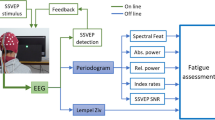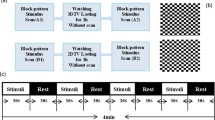Abstract
Advances in information technologies have resulted in people spending increasing amounts of time staring at electronic screens. Long-term use of computers, mobile phones, and tablets can cause eye soreness and fatigue, but can also cause more serious conditions including myopia, cataracts, and glaucoma. This study assesses changes in brain wave activity detected by eight electrodes targeting different brain regions to identify and assess the brain wave patterns in the regions associated with visual fatigue under various visual presentation methods. Furthermore, linear discriminant analysis and Min–Max scaling techniques are applied to develop a visual fatigue assessment model to quantify visual fatigue. Finally, experiments are run to assess the impact of screen size (smartphone, tablet, computer) and visual presentation mode (2D, 3D, AR, VR) on visual fatigue. This study finds that (1) the brain wave features which influence the reaction to 2D and 3D imaging are the delta and theta waves at the prefrontal Fp1 and Fp2 poles. When viewing AR images, the alpha bands at the O1 and O2 poles of the occipital lobe show a relatively clear impact, while the delta and theta waves at the C3 pole in the left center area are associated with VR images; (2) larger screens cause greater visual fatigue, indicating that excessive visual stimulation will increase visual loading and thus produce greater visual fatigue; (3) the results show that VR can cause quite severe visual fatigue, along with motion sickness passed on sensory mismatch. Therefore, it is recommended to avoid viewing experiences that are inconsistent with the brain’s physiological experience, such as walking while viewing a mobile phone, or reading in a moving car. The proposed visual fatigue assessment model provides easy and objective quantification of visual fatigue indicators, contributing to the reduction of risk for eye injury and disease.






Similar content being viewed by others
Change history
03 November 2020
The original article has been corrected: in Figure 4 the label for part (b) was missing
References
Heuer H, Hollendiek G, Kröger H, Römer T (1989) Die Ruhelage der Augen und ihr Einfluß auf Beobachtungsabstand und visuelle Ermüdung bei Bildschirmarbeit (Rest position of the eyes and the influence of observation distance and visual fatigue on VDT work). Z Exp Angew Psychol 36(4):538–566
Li HO, Seo J, Kham K, Lee S (2008a) Method of measuring subjective 3D visual fatigue: a five-factor model. In: Digital holography and three-dimensional imaging (p. DWA5). Optical Society of America. https://doi.org/10.1364/DH.2008.DWA5
Gutiérrez J, Pérez P, Jaureguizar F, Cabrera J, García N (2011) Subjective assessment of the impact of transmission errors in 3DTV compared to HDTV. In: 3DTV IEEE Conference: The True Vision-Capture, Transmission and Display of 3D Video (3DTV-CON). pp 1–4.https://doi.org/10.1109/3DTV.2011.5877209
Yano S, Ide S, Mitsuhashi T, Thwaites H (2002) A study of visual fatigue and visual comfort for 3D HDTV/HDTV images. Displays 23(4):191–201. https://doi.org/10.1016/S0141-9382(02)00038-0
Kim D, Jung YJ, Kim E, Ro YM, Park H (2011) Human brain response to visual fatigue caused by stereoscopic depth perception. In: 2011 International Conference on IEEE Digital Signal Processing (DSP). pp 1–5.https://doi.org/10.1109/ICDSP.2011.6004997
Chen C, Li K, Wu Q, Wang H, Qian Z, Sudlow G (2013) EEG-based detection and evaluation of fatigue caused by watching 3DTV. Displays 34(2):81–88. https://doi.org/10.1016/j.displa.2013.01.002
Chen C, Wang J, Li K, Wu Q, Wang H, Qian Z, Gu N (2014) Assessment visual fatigue of watching 3DTV using EEG power spectral parameters. Displays 35(5):266–272. https://doi.org/10.1016/j.displa.2014.10.001
Wang AH, Chen MT (2000) Effects of polarity and luminance contrast on visual performance and VDT display quality. Int J Ind Ergon 25(4):415–421. https://doi.org/10.1016/S0169-8141(99)00040-2
Lin CC, Huang KC (2006) Effects of ambient illumination and screen luminance combination on character identification performance of desktop TFT-LCD monitors. Int J Ind Ergon 36(3):211–218. https://doi.org/10.1016/j.ergon.2005.11.004
Lin YH, Chen CY, Lu SY, Lin YC (2008) Visual fatigue during VDT work: effects of time-based and environment-based conditions. Displays 29(5):487–492. https://doi.org/10.1016/j.displa.2008.04.003
Lee DS, Ko YH, Shen IH, Chao CY (2011) Effect of light source, ambient illumination, character size and interline spacing on visual performance and visual fatigue with electronic paper displays. Displays 32(1):1–7. https://doi.org/10.1016/j.displa.2010.09.001
Chu C, Rosenfield M, Portello JK, Benzoni JA, Collier JD (2011) A comparison of symptoms after viewing text on a computer screen and hardcopy. Ophthalmic Physiol Opt 31(1):29–32. https://doi.org/10.1111/j.1475-1313.2010.00802.x
Kooi FL, Toet A (2004) Visual comfort of binocular and 3D displays. Displays 25(2):99–108. https://doi.org/10.1016/j.displa.2004.07.004
Lee EC, Heo H, Park KR (2010) The comparative measurements of eyestrain caused by 2D and 3D displays. IEEE Trans Consum Electron 56(3):1677–1683. https://doi.org/10.1109/TCE.2010.5606312
Bando T, Iijima A, Yano S (2012) Visual fatigue caused by stereoscopic images and the search for the requirement to prevent them: a review. Displays 33(2):76–83. https://doi.org/10.1016/j.displa.2011.09.001
Lee H, Whang KW (2012) A quantitative measurement of LCD and PDP TVs for human visual preference and fatigue. Displays 33(1):1–6. https://doi.org/10.1016/j.displa.2011.08.001
Wang Q, Xu H, Gong R, Cai J (2015) Investigation of visual fatigue under LED lighting based on reading task. Optik 126(15–16):1433–1438. https://doi.org/10.1016/j.ijleo.2015.04.033
Nunez PL, Srinivasan R (2007) Electroencephalogram. Scholarpedia 2(2):1348. https://doi.org/10.4249/scholarpedia.1348
Rakic P (1988) Specification of cerebral cortical areas. Science 241(4862):170–176. https://doi.org/10.1126/science.3291116
Kandel ER, Schwartz JH, Jessell TM, Siegelbaum SA, Hudspeth AJ (2013) Principles of neural science, 5th edn. McGraw-Hill Medical, New York. ISBN:9780071390118
Ribas GC (2010) The cerebral sulci and gyri. Neurosurg Focus 28(2):E2. https://doi.org/10.3171/2009.11.FOCUS09245
Kim YJ, Lee EC (2011) EEG based comparative measurement of visual fatigue caused by 2D and 3D displays. In: International Conference on Human–Computer Interaction.https://doi.org/10.1007/978-3-642-22095-1_59
Park S, Won MJ, Lee EC, Mun S, Park MC, Whang M (2015) Evaluation of 3D cognitive fatigue using heart–brain synchronization. Int J Psychophysiol 97(2):120–130. https://doi.org/10.1016/j.ijpsycho.2015.04.006
Li HO (2010) Human factor research on the measurement of subjective three dimensional fatigue. J Broadcast Eng 15(5):607–616. https://doi.org/10.5909/JBE.2010.15.5.607
Mourant RR, Chantadisai LR (1981) Visual fatigue and cathode ray tube display terminals. Hum Factors 23(5):529–540. https://doi.org/10.1177/001872088102300503
Lunn R, Banks WP (1986) Visual fatigue and spatial frequency adaptation to video displays of text. Hum Fact J Hum Fact Ergon Soc 28(4):457–464. https://doi.org/10.1177/001872088602800407
Li HO, Seo J, Kham K, Lee S (2008b) Measurement of 3D visual fatigue using event-related potential (ERP): 3D oddball paradigm. In: IEEE 2008 3DTV Conference: The True Vision-Capture, Transmission and Display of 3D Video.https://doi.org/10.1109/3DTV.2008.4547846
Sakurada T, Kawase T, Komatsu T, Kansaku K (2015) Use of high-frequency visual stimuli above the critical flicker frequency in a SSVEP-based BMI. Clin Neurophysiol 126(10):1972–1978. https://doi.org/10.1016/j.clinph.2014.12.010
Chen C, Wang J, Li K, Liu Y, Chen X (2015) Visual fatigue caused by watching 3DTV: an fMRI study. Biomed Eng Online 14(1):1. https://doi.org/10.1186/1475-925X-14-S1-S12
Park S, Won MJ, Mun S, Lee EC, Whang M (2014) Does visual fatigue from 3D displays affect autonomic regulation and heart rhythm? Int J Psychophysiol 92(1):42–48. https://doi.org/10.1016/j.ijpsycho.2014.02.003
Pang S, Ozawa S, Kasabov N (2005) Incremental linear discriminant analysis for classification of data streams. IEEE Trans Syst Man Cybern Part B Cybern 35(5):905–914. https://doi.org/10.1109/TSMCB.2005.847744
Zhong F, Zhang J (2013) Linear discriminant analysis based on L1-norm maximization. IEEE Trans Image Process 22(8):3018–3027. https://doi.org/10.1109/TIP.2013.2253476
Li J, Chen C, Liu Y, Chen X (2016) Small-world brain functional network altered by watching 2D/3DTV. J Vis Commun Image R 38:433–439. https://doi.org/10.1016/j.jvcir.2016.03.023
Iatsun I, Larabi MC, Fernandez-Maloigne C (2015) Investigation and modeling of visual fatigue caused by S3D content using eye-tracking. Displays 39:11–25. https://doi.org/10.1016/j.displa.2015.07.001
Nalivaiko E, Davis SL, Blackmore KL, Vakulin A, Nesbitt KV (2015) Cybersickness provoked by head-mounted display affects cutaneous vascular tone, heart rate and reaction time. Physiol Behav 151:583–590. https://doi.org/10.1016/j.physbeh.2015.08.043
Kim H, Lee J (2015) A study on the possibility of implementing a real-time stereoscopic 3D rendering TV system. Displays 40:24–34. https://doi.org/10.1016/j.displa.2015.05.001
Vinnikov M, Allison RS, Fernandes S (2016) Impact of depth of field simulation on visual fatigue: Who are impacted? and how? Int J Hum Comput Stud 91:37–51. https://doi.org/10.1016/j.ijhcs.2016.03.001
Slobounov SM, Ray W, Johnson B, Slobounov E, Newell KM (2015) Modulation of cortical activity in 2D versus 3D virtual reality environments: an EEG study. Int J Psychophysiol 95(3):54–260. https://doi.org/10.1016/j.ijpsycho.2014.11.003
Soto C, Vargas M, Uribe-Quevedo A, Jaimes N, Kapralos B (2015) AR stereoscopic 3D human eye examination app. In: 2015 IEEE International Conference on Interactive Mobile Communication Technologies and Learning (IMCL).https://doi.org/10.1109/IMCTL.2015.7359594
Lambooij MT, IJsselsteijn WA, Heynderickx I (2007) Visual discomfort in stereoscopic displays: a review. In: Proceedings of the SPIE 6490, Stereoscopic Displays and Virtual Reality Systems XIV, 64900I.https://doi.org/10.1117/12.705527
Sayed K, Kamel M, Alhaddad M, Malibary HM, Kadah YM (2017) Characterization of phase space trajectories for brain–computer Interface. Biomed Signal Process Control 38:55–66. https://doi.org/10.1016/j.bspc.2017.05.007
Meyberg S, Werkle-Bergner M, Sommer W, Dimigen O (2015) Microsaccade-related brain potentials signal the focus of visuospatial attention. NeuroImage 104:79–88. https://doi.org/10.1016/j.neuroimage.2014.09.065
Jap BT, Lal S, Fischer P, Bekiaris E (2009) Using EEG spectral components to assess algorithms for detecting fatigue. Expert Syst Appl 36(2):2352–2359. https://doi.org/10.1016/j.eswa.2007.12.043
Jap BT, Lal S, Fischer P (2011) Comparing combinations of EEG activity in train drivers during monotonous driving. Expert Syst Appl 38(1):996–1003. https://doi.org/10.1016/j.eswa.2010.07.109
de Amorim RC, Hennig C (2015) Recovering the number of clusters in data sets with noise features using feature rescaling factors. Inform Sci 324:126–145. https://doi.org/10.1016/j.ins.2015.06.039
Regan EC, Price KR (1994) The frequency of occurrence and severity of side-effects of immersion virtual reality. Aviat Space Environ Med 65(6):527–530
Cobb SV, Nichols S, Ramsey A, Wilson JR (1999) Virtual reality-induced symptoms and effects (VRISE). Presence Teleoper Virtual Environ 8(2):169–186. https://doi.org/10.1162/105474699566152
Chen YC, Duann JR, Chuang SW, Lin CL, Ko LW, Jung TP, Lin CT (2010) Spatial and temporal EEG dynamics of motion sickness. NeuroImage 49(3):2862–2870. https://doi.org/10.1016/j.neuroimage.2009.10.005
Ko LW, Wei CS, Jung TP, Lin CT (2011) Estimating the level of motion sickness based on EEG spectra. In: International Conference on Foundations of Augmented Cognition.https://doi.org/10.1007/978-3-642-21852-1_21
Lin CT, Tsai SF, Ko LW (2013) EEG-based learning system for online motion sickness level estimation in a dynamic vehicle environment. IEEE Trans Neural Netw Learn Syst 24(10):1689–1700. https://doi.org/10.1109/TNNLS.2013.2275003
Treisman M (1977) Motion sickness: an evolutionary hypothesis. Science 197(4302):493–495. https://doi.org/10.1126/science.301659
Reason JT (1978) Motion sickness adaptation: a neural mismatch model. J R Soc Med 71(11):819. https://doi.org/10.1177/014107687807101109
Bos JE, Bles W, Groen EL (2008) A theory on visually induced motion sickness. Displays 29(2):47–57. https://doi.org/10.1016/j.displa.2007.09.002
Stanney KM, Kennedy RS, Drexler JM (1997) Cybersickness is not simulator sickness. Proc Hum Factors Ergon Soc Annu Meet 41(2):1138–1142. https://doi.org/10.1177/107118139704100292
LaViola JJ (2000) A discussion of cybersickness in virtual environments. ACM SIGCHI Bull 32(1):47–56. https://doi.org/10.1145/333329.333344
Choi MH, Alquzi MB, Hong M (2014) Assessment of human perceptual sensitivity to physically non-conforming motion in virtual environments. J Supercomput 69(3):1311–1323. https://doi.org/10.1007/s11227-014-1169-y
Lin H, Wu FG, Cheng YY (2013) Legibility and visual fatigue affected by text direction, screen size and character size on color LCD e-reader. Displays 34(1):49–58. https://doi.org/10.1016/j.displa.2012.11.006
Acknowledgement
The authors would like to give thanks to the Ministry of Science and Technology of Taiwan for Grant MOST 107-2410-H-025-010-MY2.
Author information
Authors and Affiliations
Corresponding author
Additional information
Publisher's Note
Springer Nature remains neutral with regard to jurisdictional claims in published maps and institutional affiliations.
Rights and permissions
About this article
Cite this article
Lee, CC., Chiang, HS. & Hsiao, MH. Effects of screen size and visual presentation on visual fatigue based on regional brain wave activity. J Supercomput 77, 4831–4851 (2021). https://doi.org/10.1007/s11227-020-03458-w
Accepted:
Published:
Issue Date:
DOI: https://doi.org/10.1007/s11227-020-03458-w




